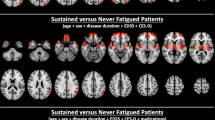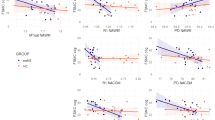Abstract
Objectives
Fatigue is a common symptom in multiple sclerosis (MS) patients, even early in the disease, but the pathophysiology remains unclear. We aimed to determine morphologic and microstructural correlates and neuropsychological parameters of cognitive fatigue in early relapsing-remitting MS patients.
Methods
Seventy-nine early relapsing-remitting MS patients (38 with fatigue and 41 without), none of whom suffered from depression, underwent neuropsychological testing. Magnetic resonance imaging was performed using anatomical and diffusion tensor imaging sequences on all patients and 40 controls. Voxel-based morphologic analysis and tract-based spatial statistics were performed.
Results
Only patients with cognitive fatigue, but not those without, exhibited alterations in the thalamic region, showing reduced thalamic fractional anisotropy and increased mean diffusivity values. No differences in lesion volume and lesion distribution were observed between patient groups. In cognitive tests, no significant differences were found between the two groups in the number of patients with pathologic scores; however, subjective cognitive impairment differed.
Conclusion
Morphological alterations and distinct microstructural changes (mainly in the thalamus) but not typical MS lesions were found to be related to cognitive fatigue in early MS. We suggest that compensatory processes adapting to these changes could initially facilitate normal cognitive performance, but also result in a feeling of fatigue.
Key points
• Morphological alterations and microstructural changes are related to fatigue in multiple sclerosis
• Thalamic alterations in particular were related to fatigue in early MS
• Fatigued patients exhibited subjective but not measurable cognitive impairment
• Compensatory processes help preserve or maintain cognitive performance but also contribute to fatigue


Similar content being viewed by others
References
Engel C, Greim B, Zettl UK (2007) Diagnostics of cognitive dysfunctions in multiple sclerosis. J Neurol 254:II30–II34
Freal JE, Kraft GH, Coryell JK (1984) Symptomatic fatigue in multiple sclerosis. Arch Phys Med Rehabil 65:135–138
Bobholz JA, Rao SM (2003) Cognitive dysfunction in multiple sclerosis: a review of recent developments. Curr Opin Neurol 16:283–288
Morrow SA, Weinstock-Guttman B, Munschauer FE, Hojnacki D, Benedict RH (2009) Subjective fatigue is not associated with cognitive impairment in multiple sclerosis: cross-sectional and longitudinal analysis. Mult Scler 15:998–1005
Jougleux-Vie C, Duhin E, Deken V, Outteryck O, Vermersch P, Zephir H (2014) Does fatigue complaint reflect memory impairment in multiple sclerosis? Mult Scler Int 2014:692468
Neumann M, Sterr A, Claros-Salinas D, Gutler R, Ulrich R, Dettmers C (2014) Modulation of alertness by sustained cognitive demand in MS as surrogate measure of fatigue and fatigability. J Neurol Sci 340:178–182
Niepel G, Bibani RH, Vilisaar J et al (2013) Association of a deficit of arousal with fatigue in multiple sclerosis: effect of modafinil. Neuropharmacology 64:380–388
Weinges-Evers N, Brandt AU, Bock M et al (2010) Correlation of self-assessed fatigue and alertness in multiple sclerosis. Mult Scler 16:1134–1140
MSCfCP (1998) Fatigue and multiple sclerosis: evidence-based management strategies for fatigue in multiple sclerosis. Multiple Sclerosis Council for Clinical Practice Guidelines
Bakshi R, Shaikh ZA, Miletich RS et al (2000) Fatigue in multiple sclerosis and its relationship to depression and neurologic disability. Mult Scler 6:181–185
Rocca MA, Mesaros S, Pagani E, Sormani MP, Comi G, Filippi M (2010) Thalamic damage and long-term progression of disability in multiple sclerosis. Radiology 257:463–469
Calabrese M, Rinaldi F, Grossi P et al (2010) Basal ganglia and frontal/parietal cortical atrophy is associated with fatigue in relapsing-remitting multiple sclerosis. Mult Scler 16:1220–1228
Genova HM, Rajagopalan V, Deluca J et al (2013) Examination of cognitive fatigue in multiple sclerosis using functional magnetic resonance imaging and diffusion tensor imaging. PLoS One 8, e78811
Chaudhuri A, Behan PO (2000) Fatigue and basal ganglia. J Neurol Sci 179:34–42
Sepulcre J, Masdeu JC, Goni J et al (2009) Fatigue in multiple sclerosis is associated with the disruption of frontal and parietal pathways. Mult Scler 15:337–344
Pellicano C, Gallo A, Li X et al (2010) Relationship of cortical atrophy to fatigue in patients with multiple sclerosis. Arch Neurol 67:447–453
DeLuca J, Genova HM, Hillary FG, Wylie G (2008) Neural correlates of cognitive fatigue in multiple sclerosis using functional MRI. J Neurol Sci 270:28–39
Riccitelli G, Rocca MA, Forn C, Colombo B, Comi G, Filippi M (2011) Voxelwise assessment of the regional distribution of damage in the brains of patients with multiple sclerosis and fatigue. AJNR Am J Neuroradiol 32:874–879
Gobbi C, Rocca MA, Riccitelli G et al (2014) Influence of the topography of brain damage on depression and fatigue in patients with multiple sclerosis. Mult Scler 20:192–201
Bester M, Lazar M, Petracca M et al (2013) Tract-specific white matter correlates of fatigue and cognitive impairment in benign multiple sclerosis. J Neurol Sci 330:61–66
Polman CH, Reingold SC, Banwell B et al (2011) Diagnostic criteria for multiple sclerosis: 2010 revisions to the McDonald criteria. Ann Neurol 69:292–302
Penner IK, Raselli C, Stöcklin M, Opwis K, Kappos L, Calabrese P (2009) The Fatigue Scale for Motor and Cognitive Functions (FSMC): validation of a new instrument to assess multiple sclerosis-related fatigue. Mult Scler 15:1509–1517
Schmidt P, Gaser C, Arsic M et al (2012) An automated tool for detection of FLAIR-hyperintense white-matter lesions in multiple sclerosis. Neuroimage 59:3774–3783
Rudick RA, Fisher E, Lee JC, Simon J, Jacobs L (1999) Use of the brain parenchymal fraction to measure whole brain atrophy in relapsing-remitting MS. Multiple Sclerosis Collaborative Research Group. Neurology 53:1698–1704
Chard DT, Parker GJ, Griffin CM, Thompson AJ, Miller DH (2002) The reproducibility and sensitivity of brain tissue volume measurements derived from an SPM-based segmentation methodology. J Magn Reson Imaging 15:259–267
Smith SM, Jenkinson M, Johansen-Berg H et al (2006) Tract-based spatial statistics: voxelwise analysis of multi-subject diffusion data. Neuroimage 31:1487–1505
Smith SM, Nichols TE (2009) Threshold-free cluster enhancement: addressing problems of smoothing, threshold dependence and localisation in cluster inference. Neuroimage 44:83–98
Takao H, Hayashi N, Ohtomo K (2014) Sex dimorphism in the white matter: fractional anisotropy and brain size. J Magn Reson Imaging 39:917–923
Harrison DM, Oh J, Roy S et al (2015) Thalamic lesions in multiple sclerosis by 7T MRI: clinical implications and relationship to cortical pathology. Mult Scler. doi:10.1177/1352458514558134
Engstrom M, Flensner G, Landtblom AM, Ek AC, Karlsson T (2013) Thalamo-striato-cortical determinants to fatigue in multiple sclerosis. Brain Behav 3:715–728
Lansley J, Mataix-Cols D, Grau M, Radua J, Sastre-Garriga J (2013) Localized grey matter atrophy in multiple sclerosis: a meta-analysis of voxel-based morphometry studies and associations with functional disability. Neurosci Biobehav Rev 37:819–830
Mesaros S, Rocca MA, Absinta M et al (2008) Evidence of thalamic gray matter loss in pediatric multiple sclerosis. Neurology 70:1107–1112
Wylezinska M, Cifelli A, Jezzard P, Palace J, Alecci M, Matthews PM (2003) Thalamic neurodegeneration in relapsing-remitting multiple sclerosis. Neurology 60:1949–1954
Tedeschi G, Dinacci D, Lavorgna L et al (2007) Correlation between fatigue and brain atrophy and lesion load in multiple sclerosis patients independent of disability. J Neurol Sci 263:15–19
Marrie RA, Fisher E, Miller DM, Lee JC, Rudick RA (2005) Association of fatigue and brain atrophy in multiple sclerosis. J Neurol Sci 228:161–166
Rocca MA, Parisi L, Pagani E et al (2014) Regional but not global brain damage contributes to fatigue in multiple sclerosis. Radiology 273:511–520
Calabrese P, Penner IK (2007) Cognitive dysfunctions in multiple sclerosis–a “multiple disconnection syndrome”? J Neurol 254:II18–II21
Penner IK, Rausch M, Kappos L, Opwis K, Radu EW (2003) Analysis of impairment related functional architecture in MS patients during performance of different attention tasks. J Neurol 250:461–472
Hoffmann S, Tittgemeyer M, von Cramon DY (2007) Cognitive impairment in multiple sclerosis. Curr Opin Neurol 20:275–280
Nocentini U, Pasqualetti P, Bonavita S et al (2006) Cognitive dysfunction in patients with relapsing-remitting multiple sclerosis. Mult Scler 12:77–87
Andreasen AK, Spliid PE, Andersen H, Jakobsen J (2010) Fatigue and processing speed are related in multiple sclerosis. Eur J Neurol 17:212–218
Van Hecke W, Nagels G, Leemans A, Vandervliet E, Sijbers J, Parizel PM (2010) Correlation of cognitive dysfunction and diffusion tensor MRI measures in patients with mild and moderate multiple sclerosis. J Magn Reson Imaging 31:1492–1498
Akbar N, Honarmand K, Feinstein A (2011) Self-assessment of cognition in multiple sclerosis: the role of personality and anxiety. Cogn Behav Neurol 24:115–121
Bove R, Musallam A, Healy BC et al (2013) No sex-specific difference in disease trajectory in multiple sclerosis patients before and after age 50. BMC Neurol 13:73
Acknowledgements
The scientific guarantor of this publication is Frauke Zipp. The authors of this manuscript declare no relationships with any companies whose products or services may be related to the subject matter of the article. This study has received funding by the Ministry of Science and Education/German Competence Network for Multiple Sclerosis (BMBF/KKNMS, B7.3 to FZ). No complex statistical methods were necessary for this paper. Institutional review board approval was obtained. Written informed consent was obtained from all subjects (patients) in this study. No study subjects or cohorts have been previously reported. Methodology: retrospective, cross sectional study, performed at one institution.
Author information
Authors and Affiliations
Corresponding author
Additional information
Frauke Zipp and Adriane Gröger contributed equally to this work.
Rights and permissions
About this article
Cite this article
Wilting, J., Rolfsnes, H.O., Zimmermann, H. et al. Structural correlates for fatigue in early relapsing remitting multiple sclerosis. Eur Radiol 26, 515–523 (2016). https://doi.org/10.1007/s00330-015-3857-2
Received:
Revised:
Accepted:
Published:
Issue Date:
DOI: https://doi.org/10.1007/s00330-015-3857-2




